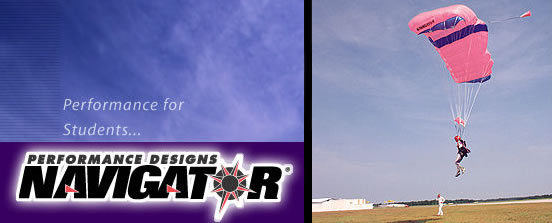

Student Performance!
Why a new
student canopy?
Landing fatalities are on the rise. We need to address this problem at the
student level by training them to be better canopy pilots. Current student
canopies were designed to be sluggish and let the student get away with
anything. The problem is that this same philosophy doesn't allow them to
learn how a "sport" canopy will respond to their inputs. The results
are often novice skydivers who have no experience flying a modern design,
yet are encouraged to purchase canopies that will respond differently than
anything they have ever experienced. Enter the Navigator…
The Problem:
Previously, the only way to provide handling comparable to a normal sport
canopy was to place the student under a slightly smaller traditional student
canopy.
The problem is that traditional student canopies don't have much flare power, by today's standards, and have always relied on a lot of wing area to provide soft, forgiving landings. With that excess wing area gone, you now have a canopy with even less flare power and a corresponding loss in forgiveness. Now the student, in order to achieve reasonable landings, has to perform flawlessly in terms of flare timing and flare speed. This makes the smaller traditional student canopy an unsuitable solution for student canopy pilot training.Since the smaller student canopy has a loss in flare effectiveness (due to the increased wing loading), the other option was to put them under a similarly sized, higher performance, zero porosity canopy. The result is that you now find the flare effectiveness has gone up, but the handling has become quite sluggish, a result many find surprising. This sluggish handling was the original problem with the larger traditional student canopy, so nothing has been gained. The next approach would then be to down size the zero porosity canopy even further. The problem now becomes airspeed. Once you have sized the zero porosity canopy to the point where the student can effectively learn piloting skills, you have unacceptably high airspeeds for a student. Again, an unacceptable risk.
The Solution:
The Navigator is specifically designed to address the student's need to learn
canopy piloting skills. It is the first canopy to bridge the gap. With its
agile, crisp handling at student wing loadings and corresponding lower (student)
airspeeds it gives the student what they need.
This combination, along with the length of the Navigator's control range and its reluctance to stall, allows for the maximum amount of learning to take place with added safety.
How did we
accomplish it?
The Navigator is a totally new design. We borrowed elements from all of our
experience in ram-air development, from tandem construction to high performance
canopy research. The result is a new breed of canopy tailored to meet the
student's and drop zone's needs simultaneously.
Openings and
landing forgiveness:
Students need a canopy that provides them with immediate feedback on opening
(very little snivel), but does not open hard. The Navigator's deployment is
designed to provide these characteristics with either spring loaded or hand
deployed pilot chutes. They also need a canopy that allows them to get away
with typical landing errors such as an early flare. With this in mind, we
have designed the flare characteristics on the Navigator to be very forgiving.
Wing loading
and in-flight response:
The Navigator is available in sizes ranging from 200 sq. ft. to 280 sq. ft.
in twenty square foot increments. The Navigator is more responsive to the
student's control inputs than older designs at equivalent wing loadings. This
allows for better feedback to the student during canopy flight. This improved
feedback will allow the student to immediately understand the effects of their
control inputs. This greatly accelerates the learning curve without the need
to put the student on a smaller canopy. This feature allows learning to take
place at appropriate airspeeds for students.
Durability:
Drop zone owners and staff want a rugged canopy with a long life span. The
Navigator is constructed with reinforcement similar to our tandem canopies.
No student canopy is stronger. In addition, we have incorporated both a zero
porosity (top surface) and a low porosity (bottom surface), similar to our
successful 384 and 425 tandem canopies. This combination allows for ease of
packing, while providing excellent landing characteristics that will far outlive
any low porosity canopy. We have even added a protective patch around the
pilot chute attachment point to help prevent damage from those times fabric
is inadvertently snagged between the grommet and bridle or link.
The Results:
The Navigator is a state of the art student canopy. It offers an unparalleled
combination of performance, forgiveness and durability, while providing the
ability to raise the level of student canopy piloting instruction. With its
cutting edge design and construction, we are confident it will outperform
any other student canopy and maintain this performance over a much longer
life span. The Navigator, along with a progressive student canopy training
program, will create safer and more competent canopy pilots. This is something
that will benefit usall.
The Performance Designs Navigator: Student Performance!
